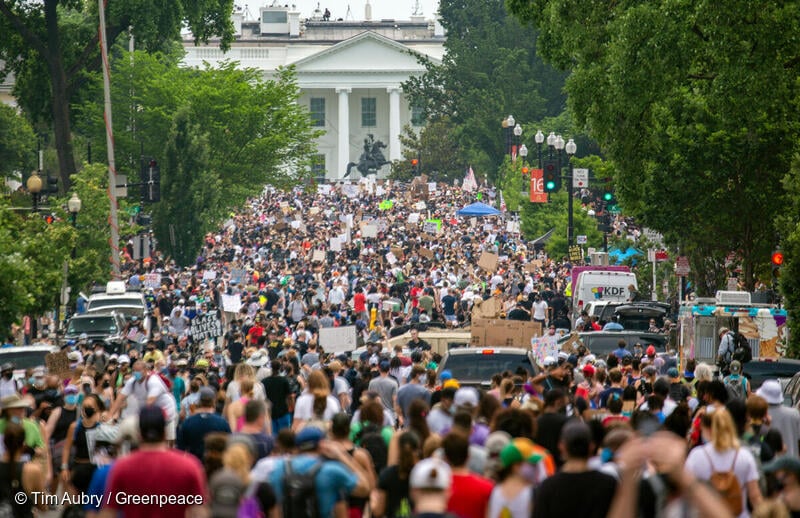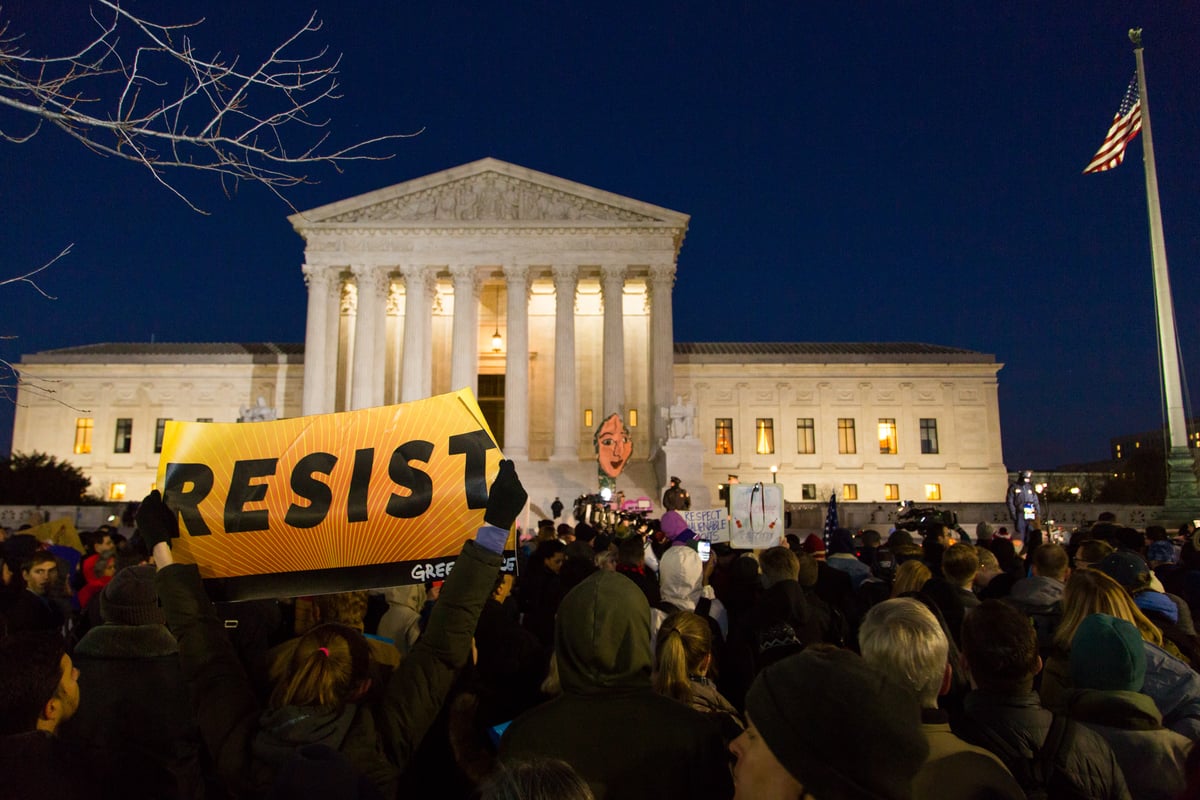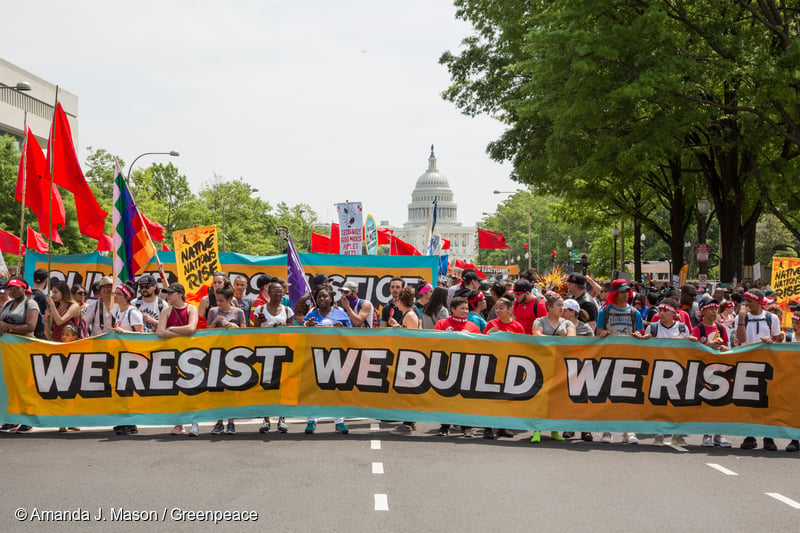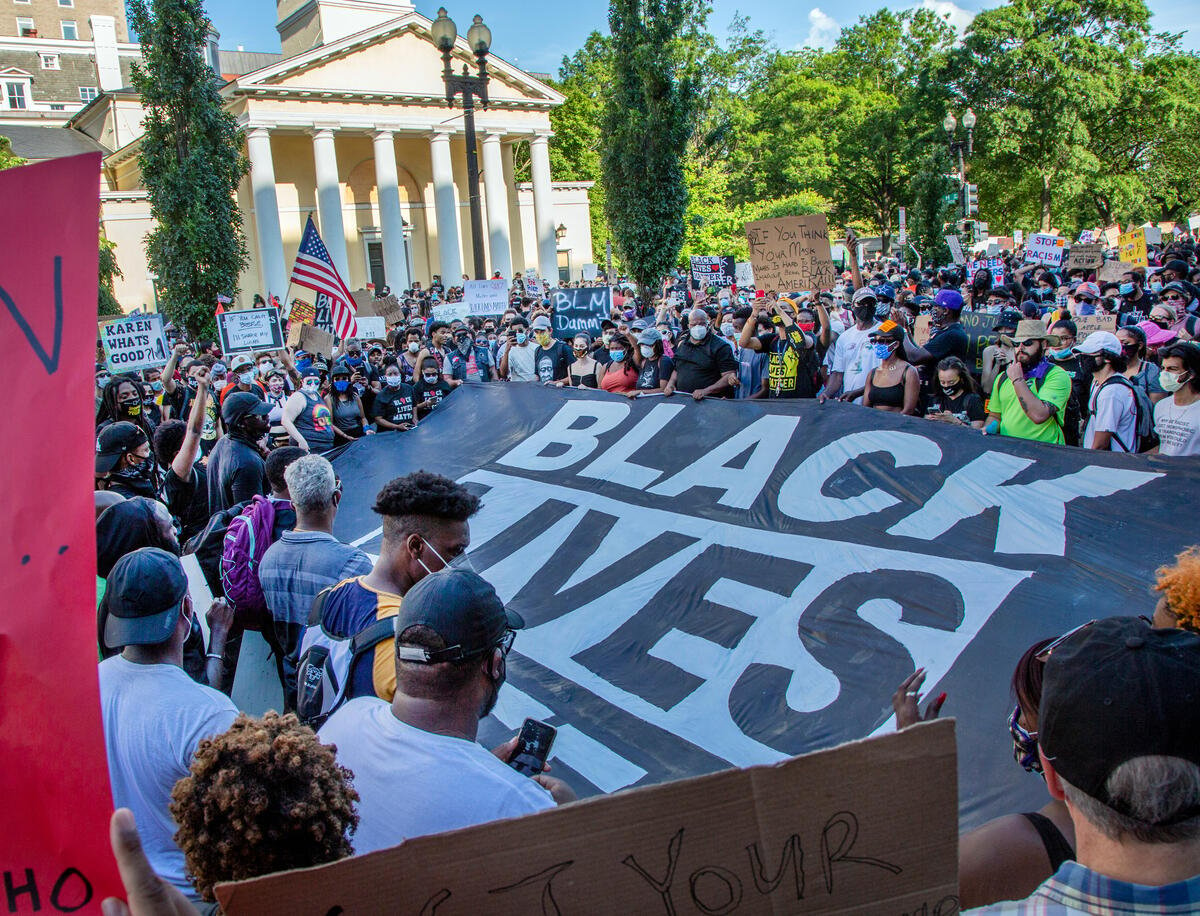
Toolkit: Protest safety tips from Greenpeace

Protest is a powerful strategy to demand justice. Greenpeace has been holding and supporting protests around the world for nearly 50 years. Because of this, we’ve received requests and messages asking for advice on protest tactics, digital, and physical security against militarized police forces. While we have compiled this from a US point of view where this Greenpeace team is based, we hope some of what is here is helpful beyond the US.
We are continuously learning, learning from mistakes, learning from each other. The activists that make up our Greenpeace community, also come from many protest practices and methods, including Indigenous-led resistance to fossil fuel extraction, the immigrant rights movement, the Movement for Black Lives, and others. We wanted to share some of our learnings so that you can join us in protests that demand systemic changes from fighting for climate justice to dismantling white supremacy. We support you and are fighting with you.
We want to acknowledge that there are many different types of protest tactics, and that this is not an exhaustive list. We also want to acknowledge that communities of color, especially Black communities and other non-Black Indigenous and communities of color, are policed differently than white communities.
When we protest we have an opportunity to demand the world we need and to understand how the issues we face are interconnected. As we fight for environmental justice, we show up for racial justice, Indigenous rights, immigrant rights, disability rights, Trans rights, and more. While this guide focuses on protests, even if you are not able to join us in the street you can support those who are protesting by providing supplies, donating to bail funds, providing rides, having important conversations with your coworkers, friends, families, and neighbors.
Also, we want to remind you that we are not your lawyers. This is not legal advice, any tips contained here are only to assist you in thinking through how to engage in protest activity. We urge you to connect with your local organizing and legal community for additional support.
What to expect at a protest

Evaluate the Event
- Research the group or organization that is hosting the event and keep in touch by following them on social media, or opting into a text message.
- Be aware that events can change quickly and unexpectedly. Organizers will likely share important information about location and messaging, they may also ask participants to volunteer or bring supplies, and they might not be able to predict how the public will respond to changing situations in the moment.
- Be prepared for large crowds — this may affect transportation and access to the location before and after the event. Prior to arriving at the protest, tell friends you are going and know how and when you plan to get home.
If there is no specific group or organization responsible for the protest consider the following:
- Research the information you have ( i.e. time, date, location).
- Does the tone and approach of the event represent your values and goals as an activist? If the answer is no, consider not going.
- Are there other events in the area that are being hosted by organizations that better align with your values? Prioritize those instead.
Make a plan
- Bring a buddy and know what makes each of you comfortable or uncomfortable!
- Establish a plan in case you get separated from your group or your cell phone battery dies, including an exit plan for how you will get home safely. Share your plan with someone who will not be attending the protest in case you need external support.
- There may be a large crowd.
- If you drive, note where you park your car.
- Be aware of your surroundings. Always know at least 2-4 different ways to get out of the crowd and to safety.
- Think about access issues: there is often a lot of walking at protests and marches, loud noises, packed crowds, and many scents, all of which can be overwhelming. Bring ear protection and have a plan for how you will leave if you need to.
- Bathrooms may not be available or accessible.
- Check in with organizers ahead of time if the event is appropriate for children, or if there will be accommodations such as language and ASL interpretation, physical accessibility, etc.
Protesting during a global health crisis
- Do not attend a protest if you are sick or have symptoms — there are plenty of other ways to get involved! If you have symptoms, please stay home.
- Wear a N95 if available. If you do not have one, you can easily make a homemade mask.
- Bring hand sanitizer and / or wipes.
- Try to maintain physical distance from others, at least six feet per CDC guidelines.
Protesting with Children
- If you have kids, make sure you consider the added logistics of bringing them to protests including accessibility, bathrooms, changing stations and safety.
- Consider writing your phone number on your child’s arm with a permanent marker, or making a bracelet/necklace with emergency contact numbers on it that your child can wear in the event that you become separated. Make a plan for emergencies with your child and talk it through with them.
- It’s never too early to start talking to your kids in age-appropriate ways about justice and oppression. Check out these resources on how to talk to your kids about race, gender, and more.
Police presence, escalations without cause, and violence at protests
We get a lot of questions about violence at protests. Our goal with this section is not to scare you away if you are new to protest but to share information that might help you better prepare. Violence at protests can take many forms and you might experience violence through no fault of your own, for instance from police officers who escalate the situation or from counter-protestors who disagree with you. When police, other security forces, and/or armed counter protestors are present, there is an elevated risk of violence. It’s also important to note that different protests see different police responses because of the way racism and white supremacy shows up in our society. For example, protests led by the Movement for Black Lives against police violence and Indigenous-led movements by water protectors, and most recently Immigrant rights-led protests to defend our communities from I.C.E. are most often met with excessive force.
In some cases, again based on who is protesting, you should be prepared for the police to use tear gas or other chemical weapons to control crowds. You can learn more about tear gas and other riot control agents here.
You will not always be able to de-escalate a situation but here are a few methods for de-escalation
- Stay calm, take a breath and look around to get your bearings if you are able to safely do so.
- Try to de-escalate by thinking about your body language, volume if you are speaking, and your identity and if you have privilege in the situation.
- Keep your hands visible.
- If possible, leave the area.
- Consider sitting down if you are with a group that can sit together and if safe to do so.
- Be mindful not to physically touch another person or their belongings, especially law enforcement, without explicit consent.
How to prepare for and react to tear gas, harmful chemicals, and other “crowd control” tactics
- Do not wear contacts.
- Do not rub your eyes.
- Avoid applying oil-based lotions or sunscreen to your skin.
- Before going, know your boundaries and the boundaries and needs of your buddy from the beginning onward.
- If the crowd starts to panic and run, consider if you can walk calmly to prevent hurting others. Encourage people around you to do the same.
- Ask consent before touching someone who is in pain from chemical weapons or touching your buddy if your vision is affected.
- Pay attention to which way the wind is blowing, and move toward the wind and away from the source of the chemicals. After being hit with tear gas, walk around in fresh air with arms lifted.
- Stay calm, panic makes it worse, the pain will pass.
- Eye washes with clean water only, avoid using milk.
- Ask for street medics if they are available.
- Continue flushing with water and expectorating (coughing & spitting). Try to expectorate in a responsible way to reduce the spread of COVID-19 and other respiratory illnesses.
- Remove clothing and place it in a plastic bag until it can be washed or thrown away.
- Take a shower in cold water, hot water will bring back the pain, be careful of your eyes in the shower.
- If symptoms persist or you develop other symptoms, seek medical care.
- Sound cannons (long range acoustic devices or LRADs) are crowd control measures that directionally project sound. Imagine a very large megaphone that can make additional noises like a deafening fire alarm. The best way to protect yourself is to take ear protection such as ear plugs to the protest.
- If you are detained, you might have your hands placed together in front of or behind you with plastic or metal handcuffs. Handcuff injuries are one of the most common protest injuries. If you keep your fists balled and flex your wrists when plasticuffs are being placed on them, you may be able to keep them from being too tight. Try not to move too much, you could tighten the cuffs. Massage your hands to promote blood flow.
Technology safety measures
- If you plan on taking your phone, disable biometrics such as face ID and fingerprint technology and set up a password of at least six digits. This is critical for keeping your information and the information of others safe. Do not store sensitive information on your phone, don’t let police look at or use your phone in any way. Police need a warrant to access your data if it is locked and password protected.
- Don’t just rely on your phone, have a backup plan. Write down important numbers, such as the numbers of who you came to the protest with and numbers for legal assistance hotlines, on your arm or keep them in a card in your pocket.
- Establish an agreed upon, secure communication method with those you attend the action with.
- Take photos and videos of the protest to amplify the event. However, do not share photos or videos of protestors’ faces. And never capture any activity with your phone that could be considered “illegal.”
What to bring
What to Bring and What to Avoid
You should bring necessary items that will allow you to stay safe, but travel as lightly as possible. Protests typically involve a lot of walking, moving and/or physical activity.
Bring:
- A government issued ID* as this may expedite your release in case of arrest. *If you can have an ID that matches your gender identity that may be helpful to you in ensuring you are placed with other people with your gender identity. Many trans people end up in isolation while in custody.
- A small amount of cash with you for things like food and drinks and change for the bus in case of arrest.
- A Mask: A N95 mask is ideal. If you do not have one, you can easily make a homemade mask. Bring an extra mask for yourself or others if you can.
- Additional cloth face covering. Such as, a scarf or bandana.
- Water.
- Snacks.
- A buddy, don’t go alone!
- Multiple signs / posters — signless protestors will thank you!
- Hand sanitizer.
- Bandages.
- Pads and tampons.
- Sunglasses or protective eyewear. Prescription eyeglasses, instead of contacts.
- Sunscreen.
- Ear protection.
- Comfortable closed toe shoes.
- Layers and clothes that will protect you from sun/heat — jails are notoriously cold even during the summer, so wearing layers at the protest may be helpful to you later on.
- Cell phone with face ID and fingerprint recognition disabled and a six digit passcode set.
- A portable cell phone charger.
- External phone batteries.
- Ear plugs.
- Change of clothes to put on in case your original clothing becomes contaminated.
- A good attitude and a readiness to listen more than you will speak.
- 2 days worth of medications with prescription.
An important note about medications: In case you may be arrested and held for a long period of time, you should bring any necessary prescription medicine in its original prescription bottle inside a ziplock bag along with a note from your doctor. You should bring enough for at least two days. If you have necessary medication is it important to understand that you may not be able to access it while you are incarcerated. Activists should take every step to make it clear to jail personnel that they have a serious medical condition (though we caution that revealing certain conditions, such as being HIV+ can impact you negatively as well) and are prescribed necessary medication. Contact jail support and let them know you need medical support in the form of prescription medication and they may be able to advocate for you.
Do not bring:
- Any valuables and anything you love and want to get back. They might get damaged, lost, broken, or confiscated.
- Any weapons or items that could be construed as weapons, including Swiss Army knives, blades, scissors etc.
- Drugs of any kind. Even if cannabis is legal in your state, it remains illegal under federal law. If you need to bring prescription medicine, please leave it in the clearly labeled prescription bottle it came in and see further information above.
- Any materials about your comrades, organizing meetings, agenda, plans, etc. There is no need to have anything on your person unless you are comfortable with law enforcement confiscating it.
Know your rights

No matter who you are or where you are, as long as you are a human being located inside of the United States, the U.S. Constitution provides you with certain rights you can invoke when you encounter law enforcement. While the police will not always protect or respect your rights, you should still invoke them by saying the below words in the following situations.
- If you are stopped by law enforcement say: Am I being detained or am I free to leave?
- If the police try to search you say: I do not consent to a search.
- If the police try to question you say: I wish to remain silent and I want to talk to a lawyer.
- Continue to invoke these rights if law enforcement does not respect them right away.
If you are attending a protest, many cities have legal support groups such as the National Lawyers Guild which organizes to provide jail support and legal observers. Jail support means that a set of people who are not arrested or detained with you provide a number so that you can call them for additional support. If there is a local jail support hotline, write the local phone number on your body so that you will have it even if all of your things are taken by police. Most people write the jail support number on their arms in permanent ink. You can and should call that number if you end up getting arrested. If you are arrested, the information that jail support will need to track you through the system is your name and date of birth. If you see someone get arrested, ask them to shout that information out to you and write it down, you can then tell a legal observer or call jail support over the phone and let them know.
The National Lawyers Guild has jail support hotline numbers here, and you can donate to local bail funds here
Additional resources you may find helpful:
- National Lawyers Guild (NLG): know your rights guides in six languages
- Vision/Change/Win and NLG: know your rights during COVID-19
- Electronic Frontier Foundation (EFF) guide to surveillance self-defense and digital security.
- EFF’s digital guide to attending a protest.
- National Immigration Project: what to do if ICE comes to your door.
- Center for Constitutional Rights: What to do if an agent knocks (FBI).
- ACLU know your rights around immigration.
- Mutant Legal: the dissident’s survival guide.
- The Trevor Project: Resources for LGBTQ2 Activists & Allies
- Frontline Medic Collective’s Protester Health & Safety Handouts
Resources for allies
How to contribute to safety and the movement:
If you have more resources/class privilege, consider bringing supplies, like water, snacks, face masks, first aid materials, etc to the protest with you to share with others or donate supplies or money to local groups that are offering supplies to protesters. You can also consider donating to bail funds to get those who are detained or arrested released from jail as soon as possible.
If you have white privilege, understand how to leverage that privilege to help protect or create space for those voices most often silenced by the systems we are protesting. Read more on how to be a good white ally here.
Activists can contribute to protests by intentionally doing the following:
- Listen more than you speak.
- Do your research.
- Do not share photos or videos of other protesters in which their faces are clearly identifiable, they are being arrested, etc. Protesters may face repercussions if they are identified, so blur faces and only document encounters with law enforcement.
- How to take photos at protests safely and responsibly.
- Before you post to social media, think about why you are posting: Are you sharing information about the protest on social media that focuses on the messages of those most affected? Consider who and what you are bringing attention to in your social media posts.
If you are not able to participate directly in higher-risk events, consider volunteering for jail support or emergency rides for those who are. Offer this directly to friends or reach out to your local bail fund organizers or local chapter of groups offering legal support to protestors such as the National Lawyers Guild.
Continue researching the issues you protested. Seek out educational resources and share them widely. Don’t expect others to do the work of educating you for you, and especially do not expect people with less privilege than you to do the work of educating you on systemic oppression.
Commit to the work beyond this moment. Turning up for a protest is an important step and can deepen what you will do months or years from now to continue dismantling systems of oppression.
As Greenpeace activists, protesting is one of the important ways that we can promote change. Thank you for participating in the movement for a more just and peaceful future.
